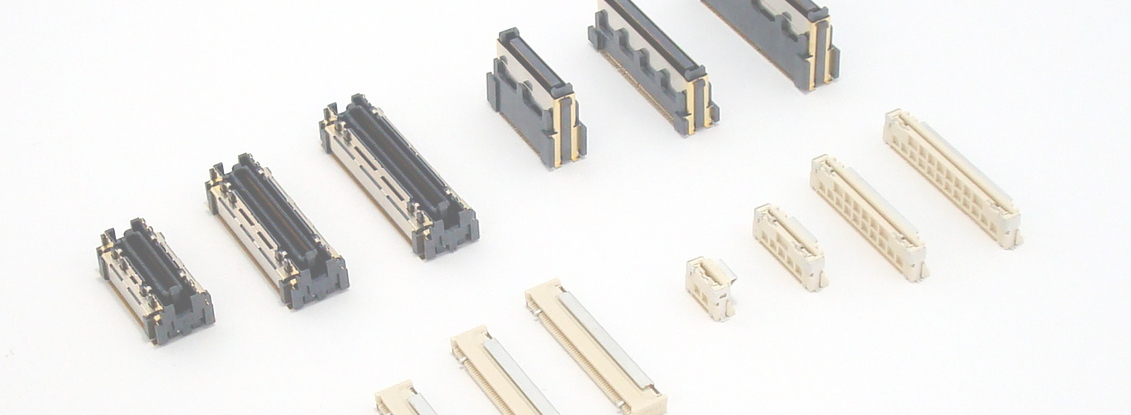

- Top
- Technical Info
- What is a connector
- How to mount the connector on the board
Flow and Reflow: Part Soldering Process
Methods for automating the soldering of parts that started by hand can be broadly divided into "flow implementation" and "reflow implementation". Flow mounting is a method in which a board containing a component is passed over a tank containing melted soldering, and solder is soldered by squirting out solder from the bottom. On the other hand, the reflow implementation is a soldering powder (cream soldering that has been pasted at the same time as the part in advance. ) in the necessary place on the substrate, pass it through a "furnace" under high temperature as if baking it in an oven, melt the solder and implement it. In recent years, surface-mount components called SMT (Surface mount technology) or SMD (Surface mount Device) have become more common in order to effectively utilize both sides of the board and to improve mounting density and productivity, and reflow is naturally becoming mainstream.
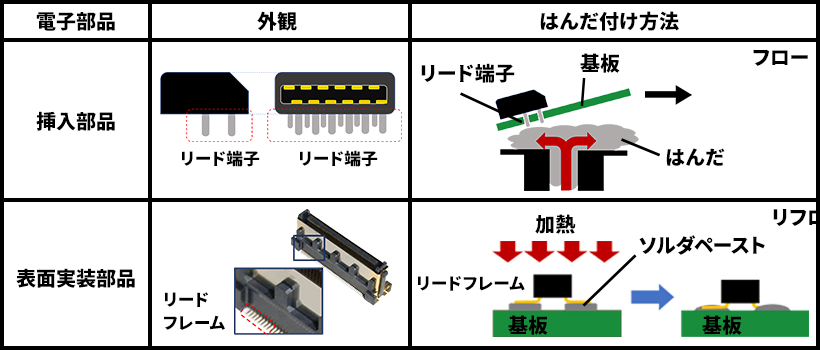
Types of each type of mounting on the board of the connector
dip type
This type is plating (VIA) with plating that makes a hole in the board and connects it to the trace, inserts the "lead" of the connector into it, and solders it. As a feature, the mechanical strength of the board mounting can be kept high, but there are also aspects where it is difficult to reduce the size and mount it at high density. In principle, connectors are soldered by hand or flow process, and the disadvantage is that it can not cope with the mainstream reflow process in recent years. However, there are also connectors with special specifications called "pinyin paste" that allow implementation in the reflow process while taking advantage of the advantages of this type (also called "through-hole reflow", "reflow dip", etc.). In this type, cream soldering once extruded out of the through-hole is soldered by sucking it up by capillary action during the process of passing through the reflow furnace.
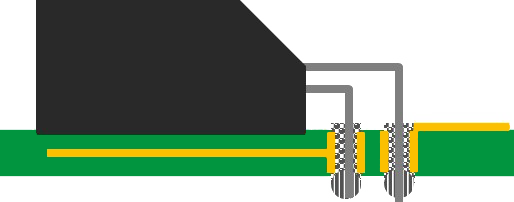
SMT type (lead frame)
This type is suitable for surface mounting, and the lead frame is placed on pads on the board coated with cream soldering and soldered in a reflow oven. Many other board-mounted components such as semiconductors also fall under this type. The legs for connection are arranged in a row in the horizontal direction, and the uniformity of the height of the legs, called coplanarity, is a more important quality control item than the DIP type due to the characteristics of surface mounting. In addition, overheating in the reflow oven can cause deformation and warping of the plastic parts of the connector.
As a feature, it is suitable for miniaturization/high-density mounting compared to the DIP type. On the other hand, in order to make up for the mounting strength to the board, which is relatively inferior, there are many cases where they have attached parts/mechanisms. In addition, since soldering leads are less likely to cause a state called "stub", there is also the advantage that it is easier to design for high-speed transmission than DIP products.

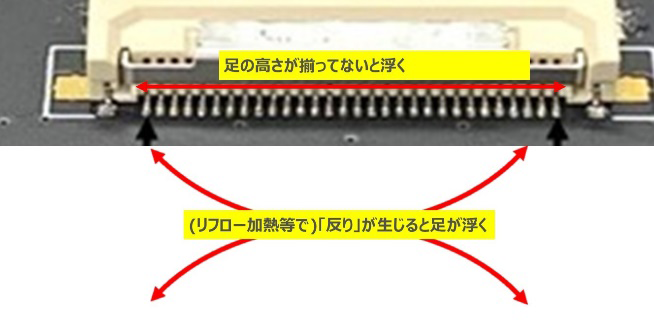
BGA type
Among the surface mounting methods, there are mounting methods on substrates called BGA (Ball Grid Array) and LGA (Land Grid Array), which are particularly used for mounting highly functional semiconductors. Among these, connectors with a mounting form similar to BGA are also appearing on the market.
The advantage is that high-density mounting is possible, and the lead from the connector to the board can be shortened, so it is suitable for high-speed transmission.
On the other hand, unlike semiconductors, stress is applied during Mating, so advanced design verification is required. The structure is somewhat complicated, the cost is high, and the method of inspecting the soldering part (although it has a proven track record in semiconductors) is different from ordinary connectors. I'm here.
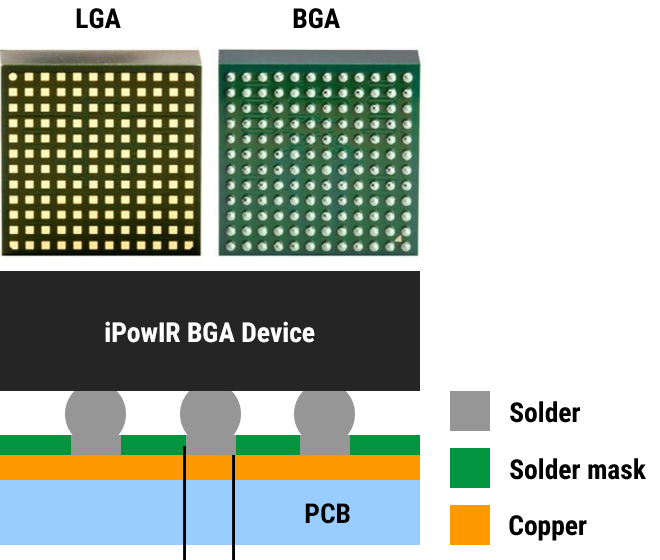
press fit type
There is a method called press-fit as a method of mounting a connector on a board without soldering. This is mounted by pressing a connector lead with a spring structure as shown in the figure into the through hole of the board. Unlike any mounting method explained so far, it is mounted by "pressing uniformly from above". Therefore, it cannot be mounted at the same time as other mounting parts, and it is necessary to mount only the connector in an independent process. In addition, a special jig is required for uniform pressing, and when the number of poles increases, a certain amount of force is required. There are many cases where
Similar to DIP, miniaturization was originally an issue, but in recent years press-fit devices have become quite small in size, and many products that support high-density mounting by adopting grids have been released. In addition, high-speed transmission obstruction due to stubs was similar to DIP, but a method of using a short-legged object and using a method called "back drilling" to open a hole on the opposite side of the board and remove the metal part that will become the stub. There are also cases where high-speed transmission is possible with
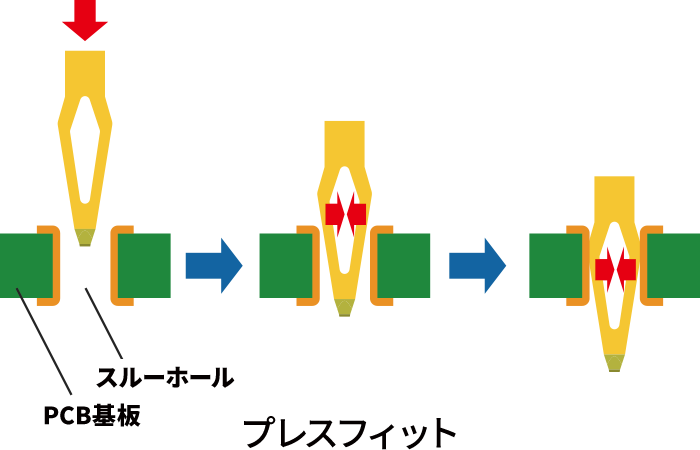
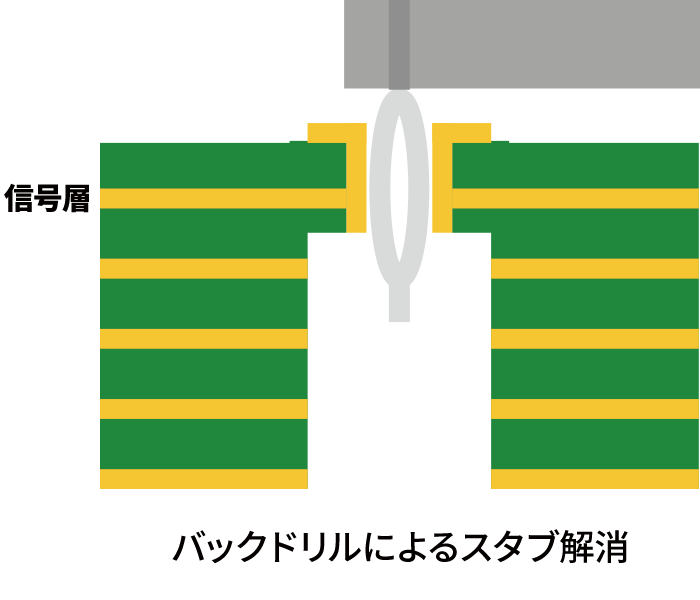
Image of high-speed transmission
As explained in each item, the image of high-speed transmission support when the SMT type is standard is shown below. However, even if it is the same type, it can be improved by various design ingenuity, and the internal structure of the connector also has a large impact. Consider the following as a general guideline only.
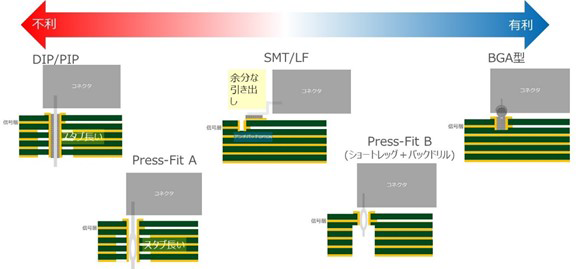
その他の高速伝送コネクタに関する情報は、こちらをご参照ください。
Other characteristics of each type
Below is a summary of the simple characteristics of each type and the corresponding implementation method. At present, it can be said that the SMT type, which has become mainstream in recent years, is the most well-balanced method. IRISO has commercialized various types of DIP products, including normal DIP products and pin-in-paste compatible DIP products, with the SMT type as the mainstream. We plan to develop BGA type and press-fit products according to needs.


